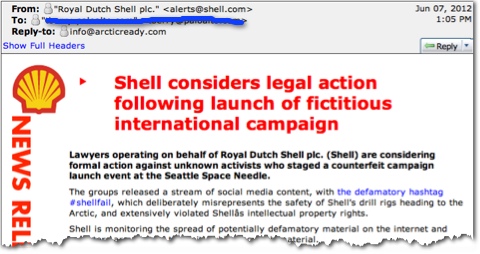Oh dear. Those nasty activists. It looked at first like PR gone bad. me thinking it was dumb of Shell Oil to send a press release huffing and puffing about “activists” making fun of it.  It looked like a press release. Curse you, activists! And like that. Shell is supposedly considering suing. The press release says:
It looked like a press release. Curse you, activists! And like that. Shell is supposedly considering suing. The press release says:
“These people have gone to great lengths to mislead the public about the age and reliability of our Arctic vessels, and otherwise damage Shell’s credibility,” said Smith. “Shell can obviously not allow this sort of misinformation to proliferate, and we are taking the firmest legal measures against the perpetrators of this campaign.”
It talks about an evil social media campaign using the hashtag #shellfail and other supposed sins. It also links to the offending website, arcticready.com.
So I went to visit the website, which is serious spoof. How clever of these “activists,” I thought, and how dumb of Shell Oil. And a nice spoof, even a collection of funny ads and a make-an-add game going on too.
But there’s the rub. I went back to the press release to discover that the email with the supposed press release is also a spoof, by the same activists. So Shell’s not as dumb as this campaign makes it look. But, on the other hand, the campaign is smart, clever, and effective. Brave new world.
Here’s a picture of the email press release supposedly from Shell Oil:

I can’t work up any sympathy at all for an oil company drilling in the arctic. But also, wow, these are very effective tactics. No?



 Can’t engineers be creative. Of course they can and are. Maybe there is a better word to use. But what I am trying to delineate between is the hard work of designing and building systems and the more abstract efforts to entertain, educate, and emote with these systems.
Can’t engineers be creative. Of course they can and are. Maybe there is a better word to use. But what I am trying to delineate between is the hard work of designing and building systems and the more abstract efforts to entertain, educate, and emote with these systems. I hate business copycats. Drives me crazy. As
I hate business copycats. Drives me crazy. As  The original Macintosh operating system borrowed from an earlier mouse and window system developed by Xerox. The iPod was not the first MP3 player, nor is the iPad the first tablet computer. These were not new ideas, but they were improvements.
The original Macintosh operating system borrowed from an earlier mouse and window system developed by Xerox. The iPod was not the first MP3 player, nor is the iPad the first tablet computer. These were not new ideas, but they were improvements.
You must be logged in to post a comment.